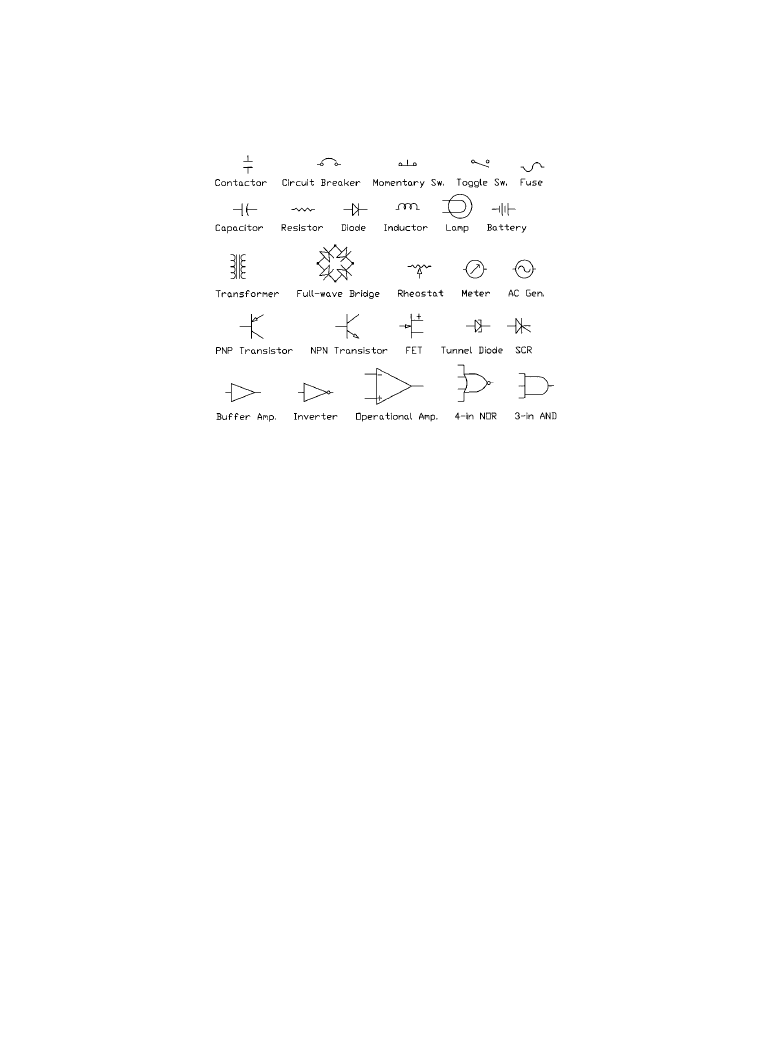ВУЗ: Казахская Национальная Академия Искусств им. Т. Жургенова
Категория: Книга
Дисциплина: Не указана
Добавлен: 03.02.2019
Просмотров: 21696
Скачиваний: 19

Production Facility Design 10-29
•
Construction detail drawing
•
Console fabrication mechanical drawing
•
Duct and conduit layout drawing
•
Single-line electrical flow diagram
Documentation Tracking
The documentation schedule provides a means of keeping track of the project’s paperwork. Dur-
ing engineering design, drawings are reviewed, and changes are made. A system for efficiently
handling changes is essential, especially on big projects that require a large amount of documen-
tation.
Completed drawings are submitted for management approval. A set of originals is signed by
the engineers and managers who are authorized to check the drawings for correctness and to
approve the plans.
Symbols
Because there are only limited informal industry standards for the design of electronic compo-
nent symbols to represent equipment and other elements in a system, custom symbols are usually
created by the designer. Each organization develops its own symbols. The symbols that exist
apply to component-level devices, such as integrated circuits, resistors, and diodes. Some com-
mon symbols apply to system-level components, such as amplifiers and speakers. Figure 10.2.7
shows some of the more common component-level symbols currently used in electronics.
Figure 10.2.7
Schematic representations of common electrical components and devices.
Downloaded from Digital Engineering Library @ McGraw-Hill (www.digitalengineeringlibrary.com)
Copyright © 2004 The McGraw-Hill Companies. All rights reserved.
Any use is subject to the Terms of Use as given at the website.
Production Facility Design

10-30 Audio Production Standards, Equipment, and System Design
The proliferation of manufacturers and equipment types makes it impractical to develop a
complete library, but, by following basic rules for symbol design, new component symbols can
be produced easily as they are added to the system.
For small systems built with a few simple components, all of the input and output signals can
be included on one symbol. However, when the system uses complex equipment with many
inputs and outputs with different types of signals, it is usually necessary to draw different dia-
grams for each type of signal. For this reason, each component requires a set of symbols, with a
separate symbol assigned for each signal type, showing its inputs and outputs only. For example,
a videotape recorder will require a set of symbols for audio, video, sync, time code, and control
signal.
If abbreviations are used, be consistent from one drawing to the next, and develop a dictionary
of abbreviations for the drawing set. Include the dictionary with the documentation.
Cross-Referencing Documentation
In order to tie all of the documentation together and to enable fabricators and installers to under-
stand the relationships between the drawings, the documents should include reference designa-
tions common to the project. That way, items on one type of document can be located on another
type. For example, the location of a piece of equipment can be indicated at its symbol on the flow
diagram so that the technician can identify it on the rack elevation drawing and in the actual rack.
A flow diagram is used by the installation technicians to assemble and wire the system com-
ponents together. All necessary information must be included to avoid confusion and delays.
When designing a symbol to represent a component in a flow diagram, include all of the neces-
sary information to identify, locate, and wire that component into the system. The information
should include the following:
•
Generic description of the component or its abbreviation. When no abbreviation exists, create
one. Include it in the project manual reference section and in the notes on the drawing.
•
Model number of the component.
•
Manufacturer of the component.
•
All input and output connections with their respective name and/or number.
Specifications
Specifications are a compilation of knowledge about how something should be done. An engi-
neer condenses years of personal experience, and that of others, into the specification. The more
detailed the specification, the higher the probability that the job will be done right.
The project manual is the document where specifications and other printed project documen-
tation is compiled.
10.2.3h
Working with the Contractors
The system engineer must provide support and guidance to contractors during the procurement,
construction, installation, testing, and acceptance phases of a project. The system engineer can
assist in ordering equipment and can help coordinate the move to a new or renovated facility.
This can be critical if a great deal of existing equipment is being relocated. In the case of new
Downloaded from Digital Engineering Library @ McGraw-Hill (www.digitalengineeringlibrary.com)
Copyright © 2004 The McGraw-Hill Companies. All rights reserved.
Any use is subject to the Terms of Use as given at the website.
Production Facility Design

Production Facility Design 10-31
equipment, the system engineer’s knowledge of prices, features, and delivery times is invaluable
to the facility owner.
The steps to assure quality workmanship from contractors on a job include the following:
•
Clarify details.
•
Clarify misunderstandings about the requirements.
•
Resolve problems that may arise.
•
Educate contractors about the requirements of the project.
•
Assure that the work conforms to the specifications.
•
Evaluate and approve change requests.
•
Provide technical support to the contractors when needed.
10.2.3i
Computer-Based Tools
Technology is evolving so rapidly that it takes a great deal of time just to keep up with the
changes. Competition forces change and improvements that would otherwise not take place at
such a rapid pace. In this environment, engineering skills must be augmented with tools to speed
the design process. Many of the tasks required of the system engineer can be accelerated and the
resulting documentation enhanced with the aid of computer programs. Computer aided design
(CAD) tools include application software from simple word processing and spreadsheet pro-
grams to complex simulation, 3-D graphic modeling, and artificial intelligence. Software is
commonly used in new construction and renovations to perform the following tasks:
•
Document tracking
•
Documentation preparation
•
Correspondence
•
Report generation
•
Technical manual publication
•
List management
•
Mechanical design
•
Electrical design
•
Schematic capture
10.2.4 Bibliography
DeSantis, Gene, Jerry C. Whitaker, and C. Robert Paulson: Interconnecting Electronic Systems,
CRC Press, Boca Raton, Fla., 1992.
Whitaker, Jerry C.: Facility Design Handbook, CRC Press, Boca Raton, Fla., 2000.
Downloaded from Digital Engineering Library @ McGraw-Hill (www.digitalengineeringlibrary.com)
Copyright © 2004 The McGraw-Hill Companies. All rights reserved.
Any use is subject to the Terms of Use as given at the website.
Production Facility Design

Downloaded from Digital Engineering Library @ McGraw-Hill (www.digitalengineeringlibrary.com)
Copyright © 2004 The McGraw-Hill Companies. All rights reserved.
Any use is subject to the Terms of Use as given at the website.
Production Facility Design

11-1
Section
11
Broadcast Transmission Systems
Radio broadcasting has been around for a long time. Amplitude modulation (AM) was the first
system that permitted voice communications to take place. In this scheme, the magnitude of the
carrier wave is varied in accordance with the amplitude and frequency of the applied audio input.
The magnitude of the incoming signal determines the magnitude of the carrier wave, while the
frequency of the modulating signal determines the rate at which the carrier wave is varied. This
simple modulation system was predominant throughout the 1920s and 1930s. Frequency modu-
lation (FM) came into regular broadcast service during the 1940s.
These two basic approaches to communicating over long distances have served the broadcast
industry well. While the basic modulating schemes still exist today, numerous enhancements
have been made, including stereo operation and subcarrier programming. New technologies have
given radio broadcasters new ways to serve their listeners.
Technology has also changed the rules by which the AM and FM broadcasting systems devel-
oped. AM radio, as a technical system, offered limited audio fidelity but provided design engi-
neers with a system that allowed uncomplicated transmitters and simple, inexpensive receivers.
FM radio, on the other hand, offered excellent audio fidelity but required a more complex and
unstable transmitter (in the early days) and complex, expensive receivers. It is, therefore, no won-
der that AM radio flourished and FM remained relatively unchanged for at least two decades fol-
lowing its introduction.
Advancements in transmitter and receiver technology during the 1960s changed the picture
dramatically. Designers found ways of producing FM transmission equipment that was reliable
and capable of high power output. Receiver manufacturers then began producing compact, high-
quality receivers at prices consumers could afford. These developments began a significant
change in listening habits that is still unfolding today. As late as the mid-1970s, AM radio sta-
tions as a whole commanded the majority of all listeners in the U.S. By 1980, however, the tables
had turned. FM is now king, and AM is still struggling to keep up with its former stepchild.
As new digital radio systems and services emerge, the radio playing field will again be
changed—just how much no one is certain. Stay tuned.
Downloaded from Digital Engineering Library @ McGraw-Hill (www.digitalengineeringlibrary.com)
Copyright © 2004 The McGraw-Hill Companies. All rights reserved.
Any use is subject to the Terms of Use as given at the website.
Source: Standard Handbook of Audio and Radio Engineering